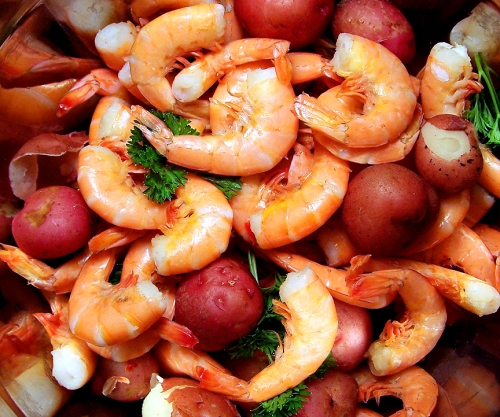This recipe comes from Howard Mitcham’s knowledgeable, rambunctious, and absolutely delightful Creole Gumbo and All That Jazz (Addison-Wesley: 1978). Howard lived in New Orleans in what many consider a golden era, (1955-70) when the city was filled with talent not only local, but brought on board by the scintillating lures of freedom and indulgence.
One of the most delicious seafood dishes to come out of New Orleans is barbecued shrimp, and once you’ve eaten it, you’ll never forget it. Barbecued shrimp have been around for a long, long time, and they’ve been served at many restaurants, but they’ve been brought to a peak of perfection by Pascal’s Manale, up- town on Napoleon Avenue. People come from miles around to eat their barbecued shrimp, and on weekend nights the place is so crowded, you have to wait two or three hours to get a table.
It is said that Manale’s secret recipe for this dish is buried in the center of a two-ton concrete block under the office safe. A friend of mine, Mrs. Ivy Whitty, solved the riddle by hiring a cook who used to work at Manale’s. The cook could neither read nor write, but she had all the treasured secrets in her head. Working together, that cook and Mrs. Whitty perfected a barbecued shrimp recipe that may or may not be Manale’s, but it is sublime.
It’s amazing that such a good dish could be so simple, but there’s nothing in it except shrimp, butter, and black pepper. If you try to add anything else-herbs, spices, Worcestershire, whatever-you’ll spoil it for certain. It’s important to use fresh shrimp with their heads and shells on if you can find them. The tomalley inside the shrimp’s head, which is like the tomalley of a lobster, adds a real punch to the sauce in the pan. (However, if you can’t find fresh shrimp, frozen unpeeled shrimp with tails will make a dish that’s almost as delicious and better than almost any shrimp dish you could find in the average seafood restaurant.)
At first glance it seems that the recipe calls for too much black pepper, but you’ll discover later that it’s just right. The heat cooks out of it-well, sort of. Always open a fresh can of black pepper when making this dish so that it will be fully aromatic and pungent. The general rule for butter is one stick per pound of shrimp plus a stick for the pan.
Use a 16-20 count; pat shrimp dry and place in the bottom of a buttered baking dish, skillet or casserole. Drizzle with melted butter—one stick to one pound of shrimp—and top with excessive amounts of freshly ground black pepper. Place on the highest rack in your hottest oven for about 10 minutes (jly).






